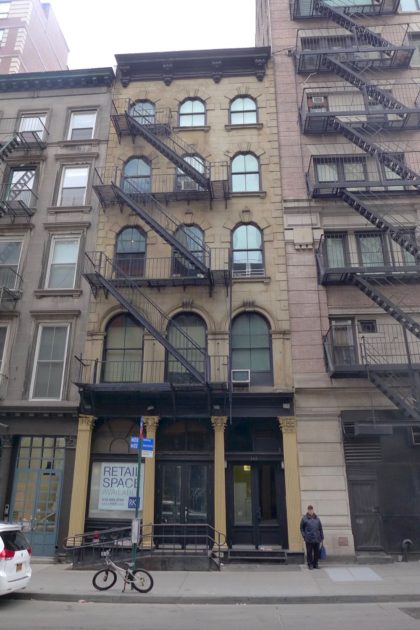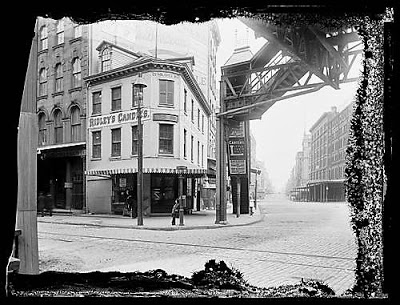The History of 143 Chambers
 Tom Miller, who writes about the history of Manhattan buildings at Daytonian in Manhattan, has allowed Tribeca Citizen to create a database of his Tribeca posts. If you enjoy these, and you will, then you should definitely check out his website, which also has write-ups about buildings all over the island. And don’t miss his book, Seeking New York: The Stories Behind the Historic Architecture of Manhattan—One Building at a Time.
Tom Miller, who writes about the history of Manhattan buildings at Daytonian in Manhattan, has allowed Tribeca Citizen to create a database of his Tribeca posts. If you enjoy these, and you will, then you should definitely check out his website, which also has write-ups about buildings all over the island. And don’t miss his book, Seeking New York: The Stories Behind the Historic Architecture of Manhattan—One Building at a Time.
··································
 As early as 1835, Ellis Potter and his wife lived in a brick house at No. 143 Chambers Street. Mrs. Potter was active in charitable work, serving as a manager of the New-York Female Assistance Society (organized for “the relief and instruction of the sick poor) in the 1830s and ’40s. Ellis was a well-to-do businessman who, as pioneers headed West, would become secretary of the Susquehanna and Wyoming Valley Railroad and Coal Company.
As early as 1835, Ellis Potter and his wife lived in a brick house at No. 143 Chambers Street. Mrs. Potter was active in charitable work, serving as a manager of the New-York Female Assistance Society (organized for “the relief and instruction of the sick poor) in the 1830s and ’40s. Ellis was a well-to-do businessman who, as pioneers headed West, would become secretary of the Susquehanna and Wyoming Valley Railroad and Coal Company.
It was most likely the intrusion of commerce onto Chambers Street that prompted the Potters to leave by 1853. That year Ellis placed an advertisement in The New York Herald offering “To Let—For one or three years, the house and lot 143 Chambers street.”
The lessee operated it as a boarding house, advertising “One room, suitable for a gentleman and lady or two single gentlemen, also one single room, to let, with or without board,” on May 29, 1855. The upscale tenor of the boarders was evidenced when one purchased a custom-built piano; then had to sell it. On the same page of The New York Herald with the ad for the rooms, another appeared that read: “A splendid $325 seven octave rosewood piano for sale for $235, made to order two months since by celebrated city markers, and fully warranted, of superior tone and finish; perfect every way. The owner is going to Paris.” The original cost of the pricey instrument would be more than $9,000 today.
Ellis Potter was understandably outraged when months earlier, in May 1854, his next door neighbor at No. 145 demolished his house to erect a new commercial building. In doing so, according to Potter’s complaint, he “removed the party-wall between the premises.” Potter took him to court on April 2, 1861. The defendant, named White, scoffed at the idea he had damaged No. 143, saying it was already “in ruinous condition.”
Potter fired back, saying his house had been fine, “and was then renting for about $1,200 to $1,400 per annum” (about $3,000 per month in 2017 dollars). He won his case, receiving a judgment of nearly $3,500.
But the damage was done and before long Potter began construction of a replacement structure himself. Completed in the spring of 1864, it outshone White’s building architecturally. Above an elegant cast iron storefront were four floors of light-colored sandstone. The graceful arched openings of the second floor were unified by shared pilasters, and dramatic scrolled keystones curled like breaking waves. The windows of the floors above were ornamented with stone voussoirs which mimicked the quoins which ran up the sides of the building. Above it all was a handsome Italianate cornice on ornate brackets.
J. Goldstein & Bro. not only managed the building, but moved into the ground floor space. On April 23, 1864, it advertised, “To let—Three lofts, in the new building 143 Chambers street, opposite Hudson River Railroad depot, suitable for jobbing or manufacturing business.” One floor had already been leased. Wm. Lehman manufactured the hoops which were so necessary for the latest fashion craze, the hoop skirt. In June, 1865, two thieves attempted to make off with “twelve coils of skirt wire, valued at $130” as reported by The New York Times. The crooks, William Gaynor and Daniel Gill, were apprehended and convicted. Gaynor was sent to the State Prison for two and a half years; Gill for one.
Ellis Potter’s building was elegant; but it was apparently difficult to fill. In May, 1868, all four upper floors were vacant, offered at “a moderate rent.” And nearly a year and a half later, in September, 1869, only one loft was occupied. That tenant was most likely Richardson & Co., dealers in “straw goods,” which was here in 1871.
Surprisingly, despite the devastating Financial Panic of 1873, No. 143 Chambers Street suddenly was tenanted. In 1874, Samuel Hirsch moved his furniture store into the first floor; Brush & Clark, real estate agents had its offices here, and Henry Lyon occupied the second floor.
Among Lyon’s employees was 19-year old James Carr, who was married and lived on Chrystie Street. Businesses in No. 143 used a “hatchway” to hoist goods up from the basement—a shaft equipped with pulleys and ropes (think of an elevator shaft without an elevator). On May 2, 1874 Carr was helping in just such a project when his teenage bravado caused disaster.
A few days later his coworkers would testify, “He had been warned not to attempt to slide down the fall-rope, but disregarding it had attempted to do so.” He lost his grip and fell from the second floor to the basement. The New York Herald said he was “seriously injured” and taken to the Park Hospital. Carr died the following day. An inquest was held and the jury rendered a verdict of accidental death.
Business went on and a few weeks later an advertisement appeared in The New York Herald. “Wanted—An errand boy from 13 to 18 years old.” The macabre circumstances surrounding the opening may have been responsible for tepid response. The following week, on June 14, a second advertisement was placed. “Wanted—An errand boy, about 15 years of age with good reference. Apply to H. Lyon.”
G. W. Teed was operating his rubber stamp manufacturing company on the floor above Henry Lyon by 1876. He advertised his “rubber name stamps” for 30 cents “an outfit.” Business was apparently good, for in May, 1877, he was looking for “agents to sell my rubber stamps—splendid terms.”
The successful wholesale liquor dealer Samuel A. Besson would operate from No. 143 Chambers for years. He lived with his wife in Yonkers, where her brother, Charles V. Martine also lived. The family was understandably concerned when the 47-year old left home on June 27, 1879, saying he had an appointment in New York City with his lawyer, William H. Pemberton.
But instead, they received a puzzling telegram from Albany saying he had arrived there safely. On July 13, with no further word from Martine, Besson placed an ad asking for information on his whereabouts. When that failed, he set off on a search. The New York Herald reported on July 22 that he “returned to the city on Saturday night after a week devoted to a search for the missing man. He visited all the summer resorts on the Hudson River, Saratoga, Lake George and some favorite retreats in Massachusetts, without obtaining any clew as to the whereabouts of Mr. Martine.” The newspaper explained the family’s worry, saying Martine “took but little money with him to defray his expenses and an insufficient supply of linen and wearing apparel for a protracted absence.” It is unclear whether he was ever found.
Equally disturbing was the incident involving one of Besson’s employees, O. P. Coleman. At 5:30 on the morning of September 28, 1884, Police Officer McDermott noticed a man apparently sleeping in the doorway of No. 209 Washington Street. The following day The New York Times ran the somewhat callous headline “Trying To Wake A Dead Man.”
McDermott discovered upon attempting to arouse what he assumed was a drunk, that the middle-aged man was deceased. A search of his pockets found three letters addressed to O. P. Coleman in care of S. A. Besson on Chambers Street. With no one else to identify the body, Samuel Besson was sent for; but he could not be found either in his office nor his Yonkers residence; so Coleman was taken to the Morgue until his employer could be located.
At some point before this time Ellis Potter had transferred title to the building to the St. James Episcopal Church. When the congregation laid plans for a new structure on Madison Avenue and 71st Street in 1884, it took out a $200,000 building loan, using No. 143 Chambers Street as partial collateral.
Among the church’s tenants in the building was Ryan & Co., makers of baseballs and “base ball goods.” Having moved here from No. 149 Fulton Street, it boasted “The Ryan Republican Dead Ball has been adopted for all professional and junior clubs throughout the country.”
On March 17, 1882, it ran a sporty advertisement for workers. “Base Ball Sewers—Come one, come all, to sew the Ryan dead ball; highest price paid; steady work.” The firm paid according to the model of ball the workers were constructing. “Price list for sewing dead balls, 85c; stars, 50c; sheepskin, 30c; large 2, 25c; large O K, 20c; small O K, 16c.”
Other tenants were James H. Flagg, cutlery, here in 1886; the printers and publishers, Irving Press; and Hardware Publishing Company, publishers of the bi-weekly Hardware; Good Value brand cigars; and Francis B. Thurber, head of the wholesale grocery firm Thurber-Whyland Company.
Irving Press Company received bad publicity in February, 1895, when it was sued by William S. Stillman. A year earlier, on January 4, William W. Thomas had hired Stillman as the firm’s manager with a $20 per week salary. The new employee should, perhaps, have been suspicious when, at the same time, Thomas asked him for a $430 loan, “to be repaid on Jan. 4, 1895.”
When January 4 came and went, and Stillman pressed Thomas for his money, he was fired. He sued for the loan plus the week and a half’s salary he never got.
 Remarkably, the 1820s house on the corner still stood in 1896. No. 143 can be glimpsed to the side, revealing a permanent awning that had been erected over the ground floor. (From the collection of the New-York Historical Society.)
Remarkably, the 1820s house on the corner still stood in 1896. No. 143 can be glimpsed to the side, revealing a permanent awning that had been erected over the ground floor. (From the collection of the New-York Historical Society.)
··································
Francis Thurber was long established well respected in the wholesale grocery business. He was elected to the Chamber of Commerce, had organized and was president of the Anti-Monopoly League, and organized the Merchants and Manufacturers’ Board of Trade.
Following the Financial Panic of 1893, his firm H. K. & F. B. Thurber failed. He reorganized as the Thurber-Whyland Company and, for all appearances, was doing well. On March 12, 1899, The Sun ran a surprising article that announced “Francis B. Thurber has been admitted to the bar at 57.” The oldest lawyer admitted to the bar in New York at the time, he explained, “My objects in being admitted to the bar were mental discipline, the putting of an example before the boy [his teen-aged son], and what seemed to me the opportunity of combining my business experience with my knowledge of law.”
In fact, there was more to the story than that. On July 12, 1901, a headline in the New-York Tribune read “F. B. Thurber Gives Up Fight.” The article reported that he his firm had declared bankruptcy.
In a statement he told how 30 years of hard work and a fortune “was swept away in the panic of 1893.” Seeing the inevitable, he procured his law degree and “am now trying, with good prospects, to establish a law practice” that he hoped “might enable me, with time, to do something for my creditors.” It was a humiliating and devastating end to Thurber’s respected career
Earlier that year, on January 12, a fire had swept through the building, causing $5,000 in damages. It started on the second floor in the offices of the United States Export Association. The publishers of The American Grocer was on the third floor, and the ground floor was home to Eugene W. Dunstan, dealers in bakery and confectioners equipment.
E. W. Dunstan suffered $500 in water damage; but would remain in the space at least through 1907. The building, now nearly half a century old, was becoming antiquated. In 1909 it was cited twice for health violations: “failure to provide sanitary water closets” and “failure to provide sufficient water to flush water closets.” The violations were repeated every year through 1912.
In April, 1911, St. James Church foreclosed on the leaseholder, Elizabeth Bennett. A new list of tenants soon filled the building, including Banner Utilities Company, which took the second floor, and hardware merchant William R. Keene who moved into the ground floor where he would remain until about 1918.
Keene got himself into trouble after his business associate and friend, Charles C. Carhart, introduced him to his wife, Eva. The meeting not only ended Keene’s and Carhart’s friendship, but the Carhart marriage. On April 15, 1913, Carhart sued his partner for $30,000 damages. He said in court that “Mrs. Carhart’s affections for him began to wane after he introduced her to Keene.”
The building continued to lure a variety of tenants over the years. In 1914, the same year that R. Heinlach’s Sons Company and the Toplin Manufacturing Company leased space, the New York Iron and Steel Products Company moved in. The firm would stay on into the 1920s. The C. R. Andrews company distributed Hyde propellers here in the 1920s and ’30s; and for years the Universal Butter and Egg Corporation operated here, finally going out of business in 1963.
The Tribeca neighborhood would soon change from gritty industrial to trendy residential and retail. In 1985 the If Every Fool Studios was located at No. 143 Chambers Street. That year it presented workshops “for an in-depth study of clowning” presented by master clowns from England, Canada and France.
In 2001, the upper floors were converted to residential spaces—one per floor. The facade survives remarkably intact, including the storefront, with its Victorian double doors and handsome cast iron elements.
··································
Photo credits from top: Tribeca Citizen; New-York Historical Society.













